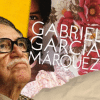Remembering Gabo

It took me years to realise that Gabriel García Márquez's whole literary corpus actually looks and sounds like a ballerina figurine: the pretty doll that emanates the saddest sound in the world. Remember how the "most handsome and well-mannered" Italian blond Pietro Crespi died in Cien años de soledad (One Hundred Years of Solitude)? On November 2, he died, under the lights of innumerable lamps and amidst the mad concert of music boxes and all the clocks that struck an interminable hour, "at the desk in the rear with his wrists cut by a razor and his hand thrust into a basin of benzoin." García Márquez's prose sounds exactly like that. Beautiful, yet sad. Festive, yet melancholy.
Gabo once compared "writing" with "carpentry." In a 1981 interview, he said to Peter Stone, "Ultimately, literature is nothing but carpentry. Both are very hard work… both are full of tricks and techniques. Basically very little magic and a lot of hard work are involved… I never have done any carpentry but it's the job I admire most, especially because you can never find anyone to do it for you."
García Márquez's career as a writer began from the cheap rooms of a brothel and ended up in the prestigious stage of the Royal Swedish Academy of Letters, History and Antiquities. It will inspire generations of literati to come and will work as a mirror, reflecting society for eons.
It would not be a mistake to compare Gabo with a carpenter. Most of his life, he worked with his prodigious power of concentration from 9am in the morning to 2:30pm in the afternoon. García Márquez's son Rodrigo Garcia wrote that his father woke up every morning, fearful of losing his path in the treacherous terrain of a novel, and by breakfast he worried that "if today doesn't go well, the whole novel might be a bust. If that's the case I would abandon it." But by lunchtime, he would come out confident enough from his study to announce that "he was writing the best novel since the great Russian novels of the nineteenth century."
Gabo used to be in a trance while working, his son recalls: "When my brother and I were children, my mother would sometimes send us into his study with a message and he would stop writing and turn to us while we delivered it. He would look right through us, his Mediterranean eyelids at half mast, a cigarette going in one hand and another burning in the ashtray, and reply nothing… even after we walked away, he remained in that position, turned toward the door, lost in a labyrinth of narrative." Rodrigo argued that "with that level of focus there was little one couldn't achieve." I want to counter Rodrigo by saying that there are very few in the world who could achieve that level of focus.
García Márquez was one of those writers who knew from the outset that he was here to do nothing but write. He used to say, "If you can live without writing, don't write." But for Gabo, writing was like breathing. I assume writing, at times, must have been monotonous for him but there was no escape; he lived each day to write and hated death because that would be the only aspect of his life that he would not be able to write about.
With that passion and persistence, Gabo became one of the prominent figures of 20th century literature who fractured our notion of reality. The literature of the last century was all about fracturing reality. Some fractured it with magic realism, some with surrealism, some others with dystopian science-fiction. This generic classification can go on for hours, but the question is: how did García Márquez fracture reality? What makes his writing so special? The answer is, of course, partly because he was an avid reader from a very early age. His shape of mind, which was shaped by the literatures of Kafka, Joyce, Wolf, Faulkner, and others clearly reflects in the intricate folds of his narratives. One could discern the ghostly silence of Juan Rulfo's Pedro Paramo (a Mexican classic) echoing in the streets of Macondo (Gabo's fictional village)—the kind of intertextuality one finds in a well-read author's narrative. But I believe this is only part of what made his writing special. The other part lies in his style of telling a tale, which he achieved from his journalism and undoubtedly from his grandmother, who used to tell him absurd stories with a remarkable seriousness in her face.
Gabo used his journalistic style to wrap reality in an enchanting cloak. He says, "If you say that there are elephants flying in the sky, people are not going to believe you. But if you say that there are four hundred and twenty-five elephants flying in the sky, people will probably believe you." This is the journalistic trick he applied to narrate One Hundred Years of Solitude. For example, the writer one day found a woman arguing with the wind so that the wind would not blow her sheets away and this spectacle led him to write the episode where Remedios the Beauty ascended towards the sky (killing his characters must have been painful for him, I reckon, because his son recollects the day Gabo destined Colonel Aureliano Buendía to death. One afternoon in Mexico city, his father came to his mother and announced, "I've killed the colonel," and the couple sat together in silence for hours).
The other technique Gabo employed in his writing was illustrating trivial incidents with precise details, which he inherited from his grandmother. Gabo once recalled how his grandmother, with a serious face, used to describe the electrician who often came to their house. His grandmother used to say, "Every time this man came around, he would leave the house full of butterflies." The electrician later emerged as Mauricio Babilonia in One Hundred Years of Solitude.
García Márquez's career as a writer began from the cheap rooms of a brothel and ended up in the prestigious stage of the Royal Swedish Academy of Letters, History and Antiquities. It will inspire generations of literati to come and will work as a mirror, reflecting society for eons. But to sustain his work, we need to develop a certain degree of intellectual acumen so that we can decipher the reality, at times the brutal realities of South America, encoded behind the magic. Gabo himself argued for this reality in his Nobel Prize lecture, and Salman Rushdie argued by pointing out the "reality" while delivering a talk on Gabriel García Márquez at Harry Ransom Center.
We must remember that "magic realism"—the term worked as a signifier to posit García Márquez's unique texts in the profound ocean of world literature—is a critically compound term, at times clever enough to confuse us. If we miss the latter, the former will reduce the texts to a bunch of fairy tales. And García Márquez's works are not mere fairy tales!
Soumalya Chatterjee, from India, is former student of Comparative Literature at Jadavpur University.
Views expressed in this article are the authors' own.
Follow The Daily Star Opinion on Facebook for the latest opinions, commentaries and analyses by experts and professionals. To contribute your article or letter to The Daily Star Opinion, see our guidelines for submission.

 For all latest news, follow The Daily Star's Google News channel.
For all latest news, follow The Daily Star's Google News channel. 









Comments